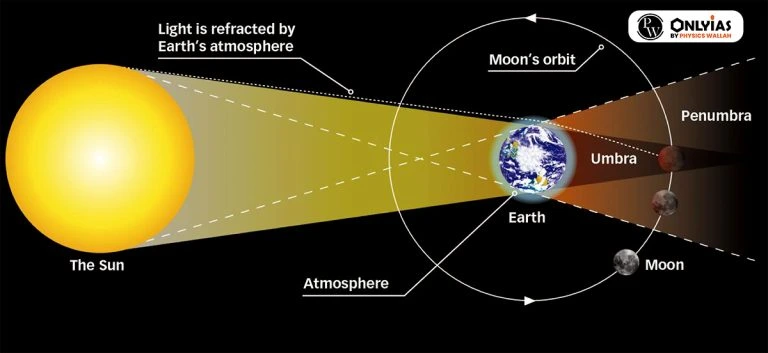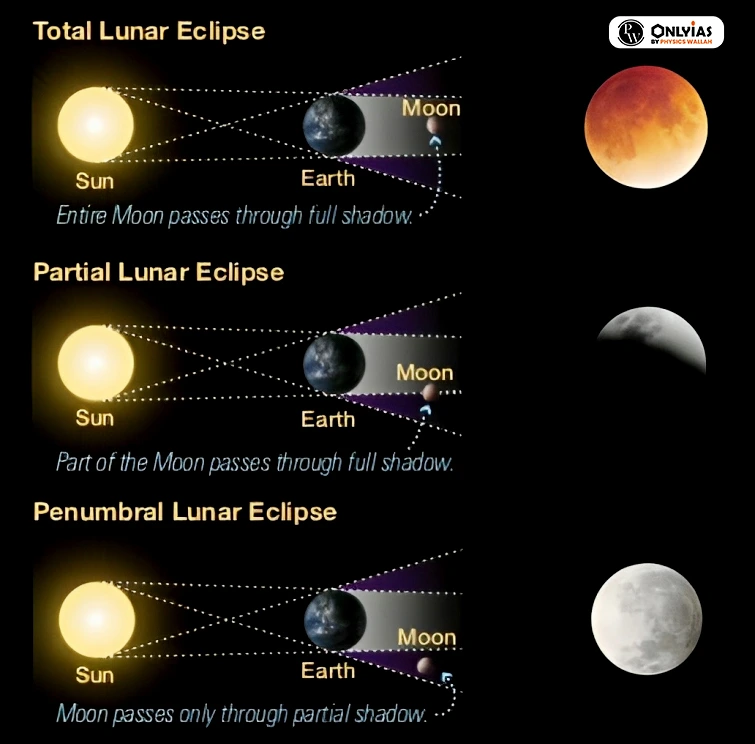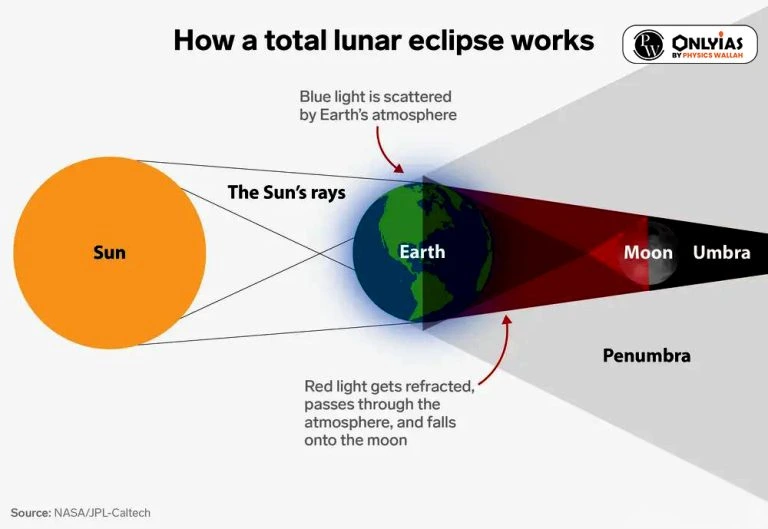Introduction : The overview of Lunar Eclipses
A lunar eclipse (Chandra grahan) is a mesmerizing celestial event where Earth passes directly between the Sun and the Moon. During this phenomenon, our planet’s shadow casts over the Moon, gradually darkening it until it takes on a reddish or copper hue, often referred to as the “blood moon.” Lunar eclipses captivate stargazers worldwide and offer a stunning spectacle of nature’s cosmic dance.
What is Lunar Eclipse (Chandra Grahan): Earth’s Shadow on the Moon?
- About: A lunar eclipse (Chandra Grahan) is an astronomical event where the Moon is darkened when it moves into the Earth’s shadow.
- The event usually occurs during the full moon phase, when the Moon’s orbital plane is nearest to that of the Earth’s orbit.
- Occurrence: Lunar eclipses are a relatively common phenomenon, with about three lunar eclipses (Chandra Grahan) occurring every year.
- A total lunar eclipse occurs once every 2.5 years on average.

- Safety: Lunar eclipses (Chandra Grahan) are completely safe to be observed with the naked eye, unlike solar eclipses.
- Shadow:
- The umbra: The Umbra is the dark center of the Earth’s shadow.
- The penumbra: The Penumbra is the outer part of the Earth’s shadow
- Mechanism of Occurrence: The phenomenon occurs when Earth passes between the Sun and the Moon.
- During this period, Earth casts a shadow on the Moon’s surface, reducing its visibility.

Types of Lunar Eclipses are Full, Partial and Penumbral
- Total Lunar Eclipse (Chandra Grahan):
- During this event, the Moon moves into the inner part of Earth’s shadow, or the umbra.
- Some part of the sunlight passes through Earth’s atmosphere and reaches the Moon’s surface, lighting it dimly.
- Partial Lunar Eclipse (Chandra Grahan):
-
- Due to the imperfect alignment of the Sun, Earth, and Moon, only part of Earth’s umbra falls on the Moon.
- This shadow increases and decreases without completely covering the Moon’s surface.

- Penumbral Eclipse:
-
- During this event, the Moon passes through Earth’s penumbra or the light outer part of its shadow.
- The Moon’s dimming is so slight that it can be difficult to notice.
The Science of Lunar Eclipses(Chandra grahan) and Revealing the Red Moon’s Mystery
- Why Does the Moon Turn Red During a Total Lunar Eclipse (Chandra Grahan)?
-
- When the Moon moves into the inner part of Earth’s shadow, or the umbra.
- Some part of the sunlight passes through Earth’s atmosphere and reaches the Moon’s surface, lighting it dimly.
- The Moon appears reddish during this event.
- The moon appears reddish in color due to the Rayleigh scattering of blue light.
- The higher the dust or clouds in Earth’s atmosphere during the event, the redder the Moon appears.
Impact of Lunar Eclipses(Chandra grahan) on Tides, Wildlife, and Cultural Beliefs
- Tidal Effect: Tidal effects on Earth are at the highest during the full moon and lunar eclipse as the Sun and Moon are in line with Earth.
- Wildlife Behavior: Studies have shown that wildlife behaves differently during a lunar eclipse.
- A study of the owl monkey showed a pronounced change in its activity during a lunar eclipse (Chandra Grahan).
- Cultural Belief: Ancient human cultures have believed that lunar eclipses are bad omen. They have indulged in human and animal sacrifice during this event.
The Scientific significance of Lunar Eclipses and Insights into Earth, Moon, and the Universe
- Scientific Significance
-
- Shape of Earth: Earth’s shadow projected on the Moon allowed ancient people to deduce that Earth was spherical.
- Lunar Diameter: Calculation of lunar diameter was possible using lunar eclipse timing.
- Longitude Determination: Previously, the chief use of total lunar eclipse was for the determination of longitude as the moment of total eclipse is the same for every station on that half of the globe.
- Star Observations: Stars that are present behind the Moon can be observed only during an eclipse as the surroundings get dimmed.
- Spectroscopic Examination: Lunar eclipse provides the opportunity of making a spectroscopic examination of the earth’s atmosphere.
- Lunar Surface: Study of lunar eclipse (Chandra Grahan) helped astronomers determine the nature of the surface they would be stepping on during the Apollo Moon mission.
- Lunar Materials: Measurements of the heat radiation of the moon as it cools down helps determine the nature of lunar materials.
- Dust in Earth’s Atmosphere: Amount of dust in Earth’s atmosphere can be determined by studying how bright or how dark each lunar eclipse is.

Exploring Lunar Eclipses Through Time: History, Culture, and Myth
-
- Cultural Significance of Lunar Eclipse (Chandra Grahan): In Literature and Art
- Historical Events: Events such as the first olympiad, the beginning of the Christian era, and the death of Augustus have been calculated by the occurrence of lunar eclipses.
- Literature: References to both lunar and solar eclipses can be found in Shakespeare’s works such as King Lear and Othello.
- Cultural Significance of Lunar Eclipse (Chandra Grahan): In Literature and Art
- Cultural Practices During Lunar Eclipse (Chandra Grahan)
- Inca People: They believed that the deep red coloring during the eclipse was a jaguar attacking and eating the moon.
- To prevent it from turning its attention towards Earth, the people would shout, shake their spears and make their dogs bark and howl, hoping to make enough noise to drive the jaguar away.
- Mesopotamia: Eclipse of Moon was believed to be a direct assault on the king. They would install a proxy king during the eclipse.
- Amerindians: The Luiseño people would sing and chant healing songs towards the darkened moon as they believed Moon to be wounded or ill.
- Depictions of Lunar Eclipse (Chandra Grahan) in Art and Culture
-
- Christian Art: Eclipses play an important part in Christian iconography. Paintings are often depicted with an eclipse in the background.
- Symbolic Representation: Eclipse was also represented as a sign, symbol, and metaphor in art, even after astronomy became a scientific field.

 GS Foundation
GS Foundation Optional Course
Optional Course Combo Courses
Combo Courses Degree Program
Degree Program












